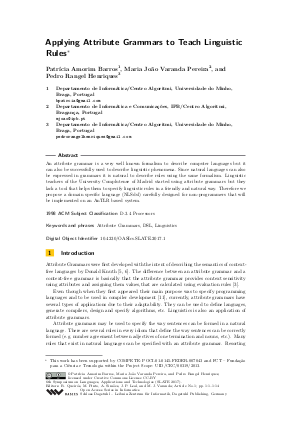Applying Attribute Grammars to Teach Linguistic Rules
Authors Patrícia Amorim Barros, Maria João Varanda Pereira, Pedro Rangel Henriques
-
Part of:
Volume:
6th Symposium on Languages, Applications and Technologies (SLATE 2017)
Part of: Series: Open Access Series in Informatics (OASIcs)
Part of: Conference: Symposium on Languages, Applications and Technologies (SLATE) - License:
 Creative Commons Attribution 3.0 Unported license
Creative Commons Attribution 3.0 Unported license
- Publication Date: 2017-10-04
File

PDF
OASIcs.SLATE.2017.1.pdf
- Filesize: 0.54 MB
- 14 pages
Document Identifiers
Subject Classification
Keywords
- Attribute Grammars
- DSL
- Linguistics
Metrics
- Access Statistics
-
Total Accesses (updated on a weekly basis)
0PDF Downloads0Metadata Views
Abstract
An attribute grammar is a very well known formalism to describe computer languages but it can also be successfully used to describe linguistic phenomena. Since natural languages can also be expressed in grammars it is natural to describe rules using the same formalism. Linguistic teachers of the University Complutense of Madrid started using attribute grammars but they lack a tool that helps them to specify linguistic rules in a friendly and natural way. Therefore we propose a domain specific language (NLSdsl) carefully designed for non-programmers that will be implemented on an AnTLR based system.
Cite As Get BibTex
Patrícia Amorim Barros, Maria João Varanda Pereira, and Pedro Rangel Henriques. Applying Attribute Grammars to Teach Linguistic Rules. In 6th Symposium on Languages, Applications and Technologies (SLATE 2017). Open Access Series in Informatics (OASIcs), Volume 56, pp. 1:1-1:14, Schloss Dagstuhl – Leibniz-Zentrum für Informatik (2017)
https://doi.org/10.4230/OASIcs.SLATE.2017.1
BibTex
@InProceedings{barros_et_al:OASIcs.SLATE.2017.1,
author = {Barros, Patr{\'\i}cia Amorim and Varanda Pereira, Maria Jo\~{a}o and Henriques, Pedro Rangel},
title = {{Applying Attribute Grammars to Teach Linguistic Rules}},
booktitle = {6th Symposium on Languages, Applications and Technologies (SLATE 2017)},
pages = {1:1--1:14},
series = {Open Access Series in Informatics (OASIcs)},
ISBN = {978-3-95977-056-9},
ISSN = {2190-6807},
year = {2017},
volume = {56},
editor = {Queir\'{o}s, Ricardo and Pinto, M\'{a}rio and Sim\~{o}es, Alberto and Leal, Jos\'{e} Paulo and Varanda, Maria Jo\~{a}o},
publisher = {Schloss Dagstuhl -- Leibniz-Zentrum f{\"u}r Informatik},
address = {Dagstuhl, Germany},
URL = {https://drops.dagstuhl.de/entities/document/10.4230/OASIcs.SLATE.2017.1},
URN = {urn:nbn:de:0030-drops-79376},
doi = {10.4230/OASIcs.SLATE.2017.1},
annote = {Keywords: Attribute Grammars, DSL, Linguistics}
}
Author Details
References
-
Zoltán Alexin, József Dombi, Károly Fábricz, and Tibor Gyimóthy. CONSTRUCTOR: A natural language interface based on attribute grammars. Acta Cybernetica, 9(3):247-255, 1990.

-
Steven Bird, Ewan Klein, and Edward Loper. Natural Language Processing with Python. O'Reilly Media, Inc., 1st edition, 2009.

- Rahmatullah Hafiz and Richard A. Frost. Modular natural language processing using declarative attribute grammars. In Ildar Batyrshin and Grigori Sidorov, editors, Advances in Artificial Intelligence: MICAI 2011, pages 291-304. Springer Berlin Heidelberg, 2011. URL: http://dx.doi.org/10.1007/978-3-642-25324-9_25.
-
Petra Horáková and Juan Pedro Cabanilles Gomar. La concordancia nominal de género en las oraciones atributivas del español: una descripción formal con gramáticas de atributos. Entrepalavras, 4(1):118-136, 2014.

-
Donald E. Knuth. Semantics of context-free languages. Mathematical Systems Theory, 2(2):127-145, 1968.

-
Donald E. Knuth. The genesis of attribute grammars. In Proceedings of the international conference on Attribute grammars and their applications, pages 1-12. Springer-Verlag, 1990.

-
Tomaž Kosar, Sudev Bohra, and Marjan Mernik. Domain-specific languages: A systematic mapping study. Information and Software Technology, 71:77-91, 2016.

-
Marjan Mernik, Jan Heering, and Anthony M. Sloane. When and how to develop domain-specific languages. ACM Comput. Surv., 37(4):316-344, December 2005.

-
Nuno Oliveira, Maria João Varanda Pereira, Pedro Rangel Henriques, Daniela da Cruz, and Bastian Cramer. VisualLISA: A visual environment to develop attribute grammars. Computer Science an Information Systems (Special issue on Advances in Languages, Related Technologies and Applications), 7(2):266-289, May 2010.

-
Fernando. Pereira and David H. D. Warren. Definite clause grammars for language analysis - a survey of the formalism and a comparison with augmented transition networks. Artificial Intelligence, 13:231-278, 1980.

-
Daniel Ravan. A graphical structure-editor that generates code for attribute grammar systems. PhD thesis, University of Windsor, 1995.

-
Daniel Rodríguez-Cerezo, Pedro Rangel Henriques, and José-Luis Sierra. Attribute grammars made easier: EvDebugger a visual debugger for attribute grammars. In International Symposium on Computers in Education (SIIE), pages 23-28. IEEE, 2014.

-
Stuart Merrill Shieber. An introduction to unification-based approaches to grammar. CSLI Publications, Stanford, California, 1986.

-
José-Luis Sierra, Ana María Fernández-Pampillon, and Alfredo Fernández-Valmayor. An environment for supporting active learning in courses on language processing. SIGCSE Bull., 40(3):128-132, June 2008.

